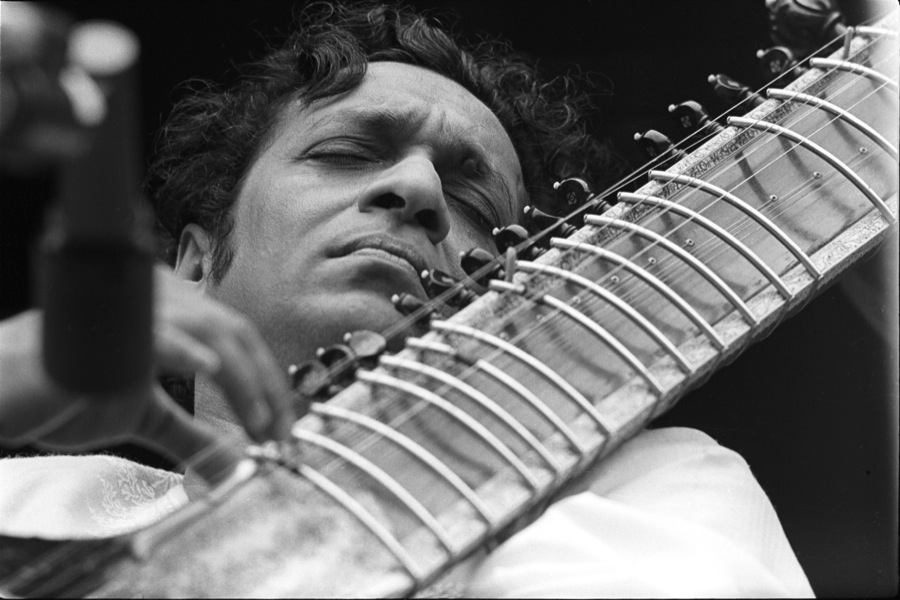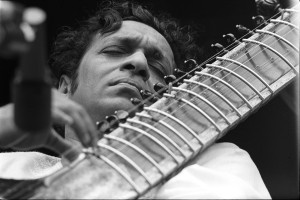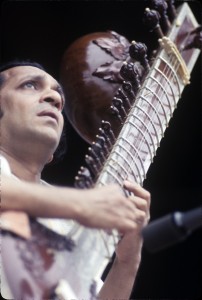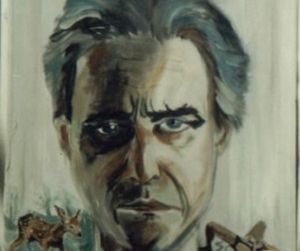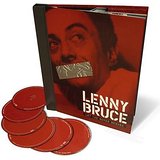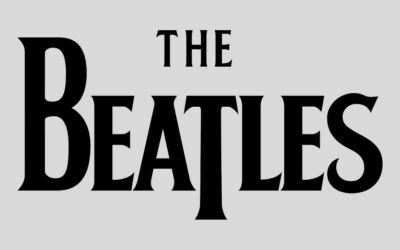By Harvey Kubernik c 2015
“The genius. The master. He opened the door to the East. The vibrations, the inner spirit of music.” — Ray Manzarek
The Grammy Museum in downtown Los Angeles has just opened its latest exhibition on Ravi Shankar, the renowned sitar player and Beatles
inspiration.
The exhibit, Ravi Shankar: A Life In Music, will celebrate India’s most esteemed musician and continue until spring 2016.
The Shankar family has provided a collection of sitars, artifacts and rare photographs that present a one-of-a-kind glimpse into the world music icon’s early life, the roots of his musicality and his vast impact on Western music.
The Museum’s 4th floor Shankar items include a collection of sitars played by Shankar, including one from the 1930s, performance attire, including outfits worn at Woodstock in 1969 and the Concert for Bangladesh, the performance box from Shankar’s final concert in 2012, rare photographs from the Shankar family collection, handwritten letters and music ideas.
“Ravi was one of a kind. He meant so much to Eastern and Western music and what they could accomplish together,” said Sukanya Shankar, Ravi Shankar’s widow. “He influenced musicians and touched the lives of millions all over the world not only with his incredible virtuosity, but with his ability to be so humble in the midst of such adoration. I am deeply touched by the efforts the Grammy Museum is making to showcase his life story for the world to see.”
“The Ravi Shankar exhibition will be a privileged glimpse into a life dedicated to, and consumed by, Indian classical music, not only played on sitar, but through all forms of instruments, voice and dance,” said Olivia Harrison, wife of the late Beatles member George Harrison, who considered Shankar to be the ‘Godfather of World Music.’
“His orchestral compositions will be a revelation to those who are only familiar with his solo music. Ravi Shankar’s worldwide travels and friendships will also add to the multifaceted picture of his colorful life and appreciation of Western culture and knowledge of jazz, classical and popular music.”
The sitarist, composer, teacher, and writer was India’s most esteemed musical ambassador and a singular phenomenon whose artistry crossed all cultural and musical boundaries. Shankar was recognized throughout the world for his pioneering work in bringing Indian music to the West.
The youngest son of a Bengali family, Shankar was born in 1920 in Varanasi (also known as Benares), the holiest of Indian cities. At age 10 he accompanied his elder brother, Uday Shankar, and his dance troupe to Paris where he attended school and absorbed the music traditions of the West.
After meeting guru and multi-instrumentalist Allauddin Khan at a music conference in 1934, Shankar moved to Maihar, India, in 1938 where he studied sitar under Khan. In 1946 Shankar went on to become music director of the New Delhi radio station All India Radio, a position he held until 1956. During his time at All India Radio, Shankar composed pieces for orchestra, mixing sitar and other Indian instruments with classical Western instrumentation.
He continued to provide well-received soundtracks in both East and West, including Kabuliwala in 1956, for which he was named Best Film Music Director at the 1957 Berlin Film Festival. He also contributed to Ralph Nelson’s Oscar-winning Charly in 1968 and, later, Shankar received an Academy Award nomination for his music in Richard Attenborough’s Gandhi. He has also recorded with conductors Andre Previn and Zubin Mehta.
Ravi Shankar in 1996 released Chants of India via Angel Records, produced by his longtime friend and musical collaborator George Harrison. Chants of India is drawn on prayers and ancient chants of Shankar’s native India. The session musicians include Harrison, tabla player Bikram Ghosh and Shankar’s daughter, Anoushka, who helped assist and conduct and is quietly gaining her own reputation as a dazzling sitar player in the shows she shares with her father.
In 1996, Angel Records issued the 4-CD retrospective of Shankar’s career, Ravi: In Celebration. This compilation was produced by George Harrison and Alan Kozlowski in association with Ravi Shankar, and according to Harrison, “The idea behind this four disc set is to show the different aspects of Ravi’s music.” The discs were arranged into Classical Sitar Music, Orchestral Indian/Ensembles, East/West Collaborations and Vocals & Experimental.
Together with composer Philip Glass and several other composers, Shankar co-composed “Orion,” which opened the 2004 Cultural Olympiad in Greece.
Shankar received five Grammy Awards throughout his career and a Recording Academy Lifetime Achievement Award, and performed at legendary U.S. music festivals including the Monterey International Pop Festival in 1967, and Woodstock in 1969.
It was in 1966 that Shankar first met George Harrison. Harrison had first heard the sitar on the set of the Beatles’ movie Help! In September of ’66, Harrison went to Bombay to study sitar with Shankar.
George would record with the instrument on John Lennon’s “Norwegian Wood (This Bird Has Flown).” Subsequently, Harrison integrated the sitar into his own composition “Love You To” from the Beatles’ Revolver album, as well as fusing sitar and Indian influences on his selection “Within You Without You,” on the influential Sgt.Pepper’s Lonely Hearts Club Band album and also on “The Inner Light,” the obscure B-side to the “Lady Madonna” single.
In an interview I conducted with Harrison in 1997 and published in HITS magazine, George mentioned his initial North London encounter with Ravi Shankar in 1966 and also reflected on his sitar work with the Beatles.
“His music was the reason I wanted to meet him. I liked it immediately, it intrigued me. I don’t know why I was so into it — I heard it, I liked it, and I had a gut feeling that I would meet him. Eventually a man from the Asian Music Circle in London arranged a meeting between Ravi and myself. Our meeting has made all the difference in my life.”
Harrison further elaborated on his own sitar playing. “I’m not a very good one, I’m afraid. The sitar is an instrument I’ve loved for a long time. For three or four years I practiced on it every day. But it’s a very difficult instrument, and one that takes a toll on you physically. It even takes a year to just learn how to properly hold it. But I enjoyed playing it, even the punishing side of it, because it disciplined me so much, which was something I hadn’t really experienced to a great extent before.”
George went on to describe his earliest attempt at playing the sitar with the Beatles, “Very rudimentary. I didn’t know how to tune it properly, and it was a very cheap sitar to begin with. So “Norwegian Wood” was very much an early experiment. By the time we recorded “Love You To” I had made some strides.” Harrison put his sitar experiments with the Beatles in perspective,
“That was the environment in the band, everybody was very open to bringing in new ideas. We were listening to all sorts of things, Stockhausen, avante-garde music, whatever, and most of it made its way onto our records.”
In 1971, Shankar partnered with Harrison to produce the Concert for Bangladesh in New York City at Madison Square Garden in August 1971 and raised funds for UNICEF. The live recording of the concert won the 1972 Grammy for Album Of The Year.
Ravi Shankar published his autobiography Raga Mala in September 2001 that was edited and introduced by George Harrison. Recommended viewing is a DVD on Shankar, Raga: A Film Journey to the Soul of India.
Over the last few decades until 2001, Harrison and Shankar would, on occasion, visit Self- Realization Fellowship in Encinitas, California, the beach community near San Diego where Shankar lived with his second wife Sukanya since 1992.
The windmill chapel at the Lake Shrine in Pacific Palisades California carries on Paramahansa Yogananda’s spiritual and humanitarian Self-Realization Fellowship work and legacy and hosted George Harrison’s funeral service in 2001.
Shankar passed away on Dec. 11, 2012, in San Diego, Calif., at the age of 92. On December 20th a memorial was held for Shankar at Self-Realization Fellowship at the Encinitas location.
The vision of Pandit Ravi Shankar can be supported by donating to the Ravi Shankar Foundation. www.JustGive.org
Sidebar
John Densmore (The Doors)
“Ray [Manzarek] had a previous relationship with World Pacific Records in 1965 when he was on the label with Rick & the Ravens and recorded for Dick Bock who owned the label, and released Ravi Shankar albums in the U.S. We got a couple hours of free studio time at World Pacific recording studios, and that’s when we got to make a demo in 1965.
“On the way into the studio Ravi Shankar is leaving with Alla Rakha, my idol, who I didn’t know was going to be my idol yet, was on the way out with these little tabla drums, which I soon find out by studying at the Kinnara School, are the most sophisticated drums in the world. I’m in awe of them. It’s the East! And, I’m just a surfer. Not literally, but from West L.A.
“The very first TM [Transcendental Meditation] class was with Clint Eastwood and Paul Horn the year before me. Paul later was in India with the Beatles. TM glued together myself, Ray, Robby and Jim. I don’t know if you know this story. Jim didn’t meditate, Robby and I went and Ray was there. That’s where we met. One time Jim came and he wanted to look into Maharishi’s eyes…and Jim later said, ‘Well, he’s got something. I’m not gonna meditate but he’s got something.’ This was the first class in the country. We were two years ahead of the Beatles, thank you (laughs).
“Robby [Krieger] and I went to Ravi Shankar’s Kinnara School of Indian Music. When you’re students at the Kinnara School of Music, you get to sit on stage with the master at UCLA’s Royce Hall. Later Robby and I go see Ravi play at the Hollywood Bowl, and George is on stage. Ravi didn’t teach at the school, but he’d drop in and give a little lecture on Sublimating Your Sexual Drive Into Your Instrument.”
End of Sidebar
In 1997, I interviewed Ravi at his home. Portions of our conversation are excerpted below.
HK: Your body of work from the 1950s and ‘60s is available on some reissues, including Ravi: In Celebration.
RS: I revisit the work on this [Ravi: In Celebration] collection. I listen and hear, “Oh, my God! It could have been a little better if it was like this…” I’m never totally one hundred percent satisfied with anything that I have done. I hear some of the items on the box set and I think of (producer/World Pacific Record’s owner) Dick Bock, or a restaurant on Vermont Ave. That happens a lot. I met such wonderful people when I first came to the U.S. to record in the mid-1950’s. Dick was such a lovable character who knew everyone. And everybody loved him. The other person I met, I don’t know if you know him, is George Avakian (producer of Louis Armstrong, Johnny Mathis, Charles Lloyd), was at Columbia Records and took me to all the Miles Davis concerts. These two were my greatest friends. On this collection, without doubt, I missed a few of them, (Laughs), which are not included. There are at least four to six other box sets that can be made with all the things that have not been together. The (new) package is so beautiful, liner notes, and George was very enthusiastic.
HK: I went back and rediscovered the work you did with jazz musicians: Bud Shank, John Handy, and I know you composed the piece, “Rich a la Rakha” for Buddy Rich and your own tabla accompanist, Alla Rakha. And you gave lessons in Indian music to Don Ellis and John Coltrane.
RS: I clicked with jazz musicians, always. From my childhood really, jazz reacted so strongly in me. Because of the rhythms and beats and the freedom to improvise, which we also have. The whole basis is different because we improvise on the ragas and have very strict rules, whereas jazz takes chords, the harmony of Western classical music, and takes a theme and then they go free, whatever they want. But they don’t observe the raga or the complicated rhythmic cycles.
HK: I know John Coltrane was going to formally study with you before he died.
RS: He was coming to learn from me. I told him, “John, why do I find so much turmoil and disturbance in your music?” He laughed and said, “That’s exactly what I’m trying to find out myself and you can help me.” We had three meetings and he came and sat twice, a very long one and a very short one in a New York hotel where I used to stay. And he wrote down many ragas, and I taught him how we improvise and he was asking me, “How do you bring the spiritual quality in your music? How do you do that?” Afterwards, he started using more drones, if you remember. I heard the turmoil in his music. He was like a child. It was a wonderful revelation for me to see this man. Dick Bock always tried to play me as much Coltrane as possible, in the car, or a few records. There I was hearing certain melody qualities that were so wonderful.
HK: The 1967 Monterey International Pop Festival. How did you get the booking?
RS: Dick Bock, of World Pacific Records, called Lou Adler. I was recording for World Pacific. Some of my recordings with jazz musicians are on that label. Dick was a wonderful person. Anyway, Monterey to me was like a revelation. Completely new. I had met George before that and that started the whole big hullaballoo, as you know. And, I saw the whole folk movement that started in England. That’s when I started seeing all the strange dress and the smell of patchouli oil, the hash and LSD. To me, it was a new world. Anyway, I had been performing in the United States since 1956. Carnegie Hall. My first fans were jazz buffs and jazz musicians and average American people.
“So, a decade later, I arrive in Monterey and see butterflies and colors and flowers with peace and love. It was fantastic. I was impressed, but everyone was stoned. But that was all right and I was meeting all these beautiful people. Fine. It was one day before my concert and I went to hear the whole thing. That to me was the real experience. One night, I really heard Otis Redding. He was fantastic. One of the best, I remember. I really like The Mamas and The Papas. Lyrical, harmony and good choruses and harpsichord. Then, you know, came the hard rock. The Jefferson Airplane. The Grateful Dead. To me it was difficult in a very loud, hurtful in-my-ear way. And Janis Joplin. I had heard of her, but there was something so gutsy about her. Like some of those fantastic jazz ladies like Billie Holliday. That sort of feeling, so I was very impressed by her. Then, some others and what really disturbed me was the hard rock.
“The worst was to come. I had heard so much about Jimi Hendrix. Everyone was talking about him. When he started playing…I was amazed…the dexterity in his guitar playing. But after two, three items, he started his antics. Making love to the guitar, I felt that was quite enough. Then, all of a sudden he puts petrol on his guitar and burns it. That was the leaving point. Sacrilegious. I knew it was a gimmick. Then, the Who followed, started kicking the drums and breaking their instruments. I was very hurt and ran away from there along with the others who play with me. My feelings were hurt deeply, as well as my respect for music and the instruments. We ran away from the festival. I said at the time, ‘Please. There is a contract and whatever you want to fine me, I won’t play. I definitely will not play in-between any of these items tomorrow.’
“So, there were talks and meetings between Dick Bock and the festival people. The next day, in the afternoon, we set up a special section between 1:00-3:00 p.m. where there would be no one in front of me and after me.
“It was cloudy, cool, it had rained a little and that’s when I played and it was like magic. Jimi Hendrix was sitting there. [Jerry] Garcia was there. I remember a few names. All of them were there and you can see on the film what magic it had. I was so impressed and it is one of my memorable performances. I didn’t plan for this. I was grateful to God that I was sitting in the atmosphere without anyone disturbing me. It drizzled for a few minutes and then it stopped. So, it was cloudy and there were flowers from Hawaii and you know, what atmosphere! After my set, it was crazy. I have never felt such a commotion of this sort. I was so pure, in spite of the fact that there were many people who were also strong. But it didn’t matter, because the whole atmosphere was so clean and beautiful and I could give my best. That’s all I can say.
HK: I know you weren’t in the Woodstock Festival movie, but I recall a live album from your appearance at Woodstock. Right?
RS: Yes. I have always said that if Monterey was the beginning of this beautiful peace of love, flowers and all that, then Woodstock was the end of it. Because it was so big. Half a million people. Rain so much that there was mud all over. You couldn’t see the people or look into their faces. Such a distance and such a vast multitude. And it looked like a big parking place. We came by helicopter and landed behind the stage and it was raining. It was a mess. But, my commitment was so strong, because I couldn’t get out of it, so I did my best. And somehow, in that atmosphere, I did my best, but I couldn’t feel anything.
HK: Was playing outdoors or at festivals a stressful situation for you or the instruments you were playing? I know after Woodstock you stopped doing pop festivals.
RS: For technical reasons, our instruments are so sensitive and delicate and weather affects pitch and completely ruins the sound and it becomes muffled. Out of control, out of tune. Even indoors, we have to be very careful not to have very strong lights. Heat, humidity affects the instruments. Now, all the halls have air conditioning. And we never have big concerts in summer or in the rainy season. The main concerts are all in the winter season, three or four months when it’s ideal weather, dry and cool. I don’t like playing outside very much, but there have been some wonderful outdoor places and performances like Tanglewood, because the weather was quite good and the great audience, and a few other places where the weather was just right.
HK: What do you want to give the audience when you perform?
RS: I can only tell you what I’ve heard, not once, but a thousand times. It comes from a black man who is a porter at the airport, or the Immigration Officer, and they say one thing, which I always get tears in my eyes: ‘Thank you for what you gave us through your music.’ Some go back to the Sixties, even 1956 or whatever, and this has always been the case. That’s what I want to do through my music. To give them, as much as is possible, love and peace and the feeling of all the different sentiments that we have, starting from romantic to playful, to happiness, to speed, to virtuosity and fun. And finally, something which is most important to me, the spiritual.
(Harvey Kubernik has been a music journalist for over 42 years and is the author of 8 books. During 2014, BackBeat Books in the U.S. and Omnibus in the U.K. published Harvey Kubernik’s book on Leonard Cohen, Everybody Knows. In autumn of 2015, the houses will be publishing Harvey’s book on Neil Young, Heart of Gold).

